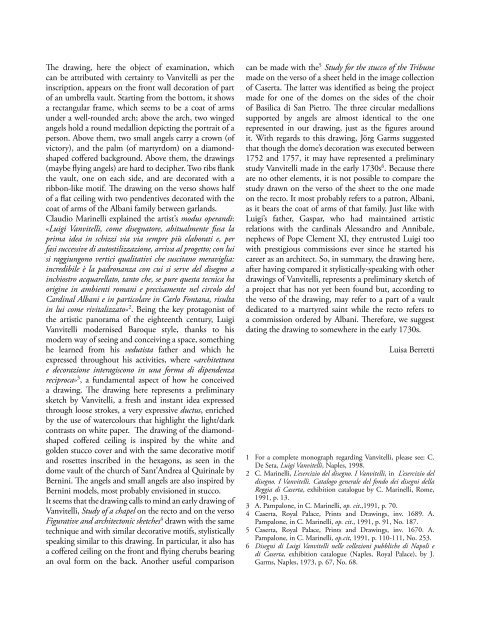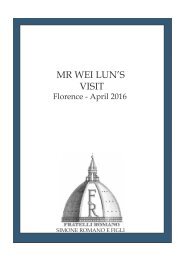A selection of master drawings 2016
- No tags were found...
Create successful ePaper yourself
Turn your PDF publications into a flip-book with our unique Google optimized e-Paper software.
The drawing, here the object <strong>of</strong> examination, which<br />
can be attributed with certainty to Vanvitelli as per the<br />
inscription, appears on the front wall decoration <strong>of</strong> part<br />
<strong>of</strong> an umbrella vault. Starting from the bottom, it shows<br />
a rectangular frame, which seems to be a coat <strong>of</strong> arms<br />
under a well-rounded arch; above the arch, two winged<br />
angels hold a round medallion depicting the portrait <strong>of</strong> a<br />
person. Above them, two small angels carry a crown (<strong>of</strong><br />
victory), and the palm (<strong>of</strong> martyrdom) on a diamondshaped<br />
c<strong>of</strong>fered background. Above them, the <strong>drawings</strong><br />
(maybe flying angels) are hard to decipher. Two ribs flank<br />
the vault, one on each side, and are decorated with a<br />
ribbon-like motif. The drawing on the verso shows half<br />
<strong>of</strong> a flat ceiling with two pendentives decorated with the<br />
coat <strong>of</strong> arms <strong>of</strong> the Albani family between garlands.<br />
Claudio Marinelli explained the artist’s modus operandi:<br />
«Luigi Vanvitelli, come disegnatore, abitualmente fissa la<br />
prima idea in schizzi via via sempre più elaborati e, per<br />
fasi successive di autostilizzazione, arriva al progetto; con lui<br />
si raggiungono vertici qualitativi che suscitano meraviglia:<br />
incredibile è la padronanza con cui si serve del disegno a<br />
inchiostro acquarellato, tanto che, se pure questa tecnica ha<br />
origine in ambienti romani e precisamente nel circolo del<br />
Cardinal Albani e in particolare in Carlo Fontana, risulta<br />
in lui come rivitalizzato» 2 . Being the key protagonist <strong>of</strong><br />
the artistic panorama <strong>of</strong> the eighteenth century, Luigi<br />
Vanvitelli modernised Baroque style, thanks to his<br />
modern way <strong>of</strong> seeing and conceiving a space, something<br />
he learned from his vedutista father and which he<br />
expressed throughout his activities, where «architettura<br />
e decorazione interagiscono in una forma di dipendenza<br />
reciproca» 3 , a fundamental aspect <strong>of</strong> how he conceived<br />
a drawing. The drawing here represents a preliminary<br />
sketch by Vanvitelli, a fresh and instant idea expressed<br />
through loose strokes, a very expressive ductus, enriched<br />
by the use <strong>of</strong> watercolours that highlight the light/dark<br />
contrasts on white paper. The drawing <strong>of</strong> the diamondshaped<br />
c<strong>of</strong>fered ceiling is inspired by the white and<br />
golden stucco cover and with the same decorative motif<br />
and rosettes inscribed in the hexagons, as seen in the<br />
dome vault <strong>of</strong> the church <strong>of</strong> Sant’Andrea al Quirinale by<br />
Bernini. The angels and small angels are also inspired by<br />
Bernini models, most probably envisioned in stucco.<br />
It seems that the drawing calls to mind an early drawing <strong>of</strong><br />
Vanvitelli, Study <strong>of</strong> a chapel on the recto and on the verso<br />
Figurative and architectonic sketches 4 drawn with the same<br />
technique and with similar decorative motifs, stylistically<br />
speaking similar to this drawing. In particular, it also has<br />
a c<strong>of</strong>fered ceiling on the front and flying cherubs bearing<br />
an oval form on the back. Another useful comparison<br />
can be made with the 5 Study for the stucco <strong>of</strong> the Tribune<br />
made on the verso <strong>of</strong> a sheet held in the image collection<br />
<strong>of</strong> Caserta. The latter was identified as being the project<br />
made for one <strong>of</strong> the domes on the sides <strong>of</strong> the choir<br />
<strong>of</strong> Basilica di San Pietro. The three circular medallions<br />
supported by angels are almost identical to the one<br />
represented in our drawing, just as the figures around<br />
it. With regards to this drawing, Jörg Garms suggested<br />
that though the dome’s decoration was executed between<br />
1752 and 1757, it may have represented a preliminary<br />
study Vanvitelli made in the early 1730s 6 . Because there<br />
are no other elements, it is not possible to compare the<br />
study drawn on the verso <strong>of</strong> the sheet to the one made<br />
on the recto. It most probably refers to a patron, Albani,<br />
as it bears the coat <strong>of</strong> arms <strong>of</strong> that family. Just like with<br />
Luigi’s father, Gaspar, who had maintained artistic<br />
relations with the cardinals Alessandro and Annibale,<br />
nephews <strong>of</strong> Pope Clement XI, they entrusted Luigi too<br />
with prestigious commissions ever since he started his<br />
career as an architect. So, in summary, the drawing here,<br />
after having compared it stylistically-speaking with other<br />
<strong>drawings</strong> <strong>of</strong> Vanvitelli, represents a preliminary sketch <strong>of</strong><br />
a project that has not yet been found but, according to<br />
the verso <strong>of</strong> the drawing, may refer to a part <strong>of</strong> a vault<br />
dedicated to a martyred saint while the recto refers to<br />
a commission ordered by Albani. Therefore, we suggest<br />
dating the drawing to somewhere in the early 1730s.<br />
Luisa Berretti<br />
1 For a complete monograph regarding Vanvitelli, please see: C.<br />
De Seta, Luigi Vanvitelli, Naples, 1998.<br />
2 C. Marinelli, L’esercizio del disegno. I Vanvitelli, in L’esercizio del<br />
disegno. I Vanvitelli. Catalogo generale del fondo dei disegni della<br />
Reggia di Caserta, exhibition catalogue by C. Marinelli, Rome,<br />
1991, p. 13.<br />
3 A. Pampalone, in C. Marinelli, op. cit.,1991, p. 70.<br />
4 Caserta, Royal Palace, Prints and Drawings, inv. 1689. A.<br />
Pampalone, in C. Marinelli, op. cit., 1991, p. 91, No. 187.<br />
5 Caserta, Royal Palace, Prints and Drawings, inv. 1670. A.<br />
Pampalone, in C. Marinelli, op.cit, 1991, p. 110-111, No. 253.<br />
6 Disegni di Luigi Vanvitelli nelle collezioni pubbliche di Napoli e<br />
di Caserta, exhibition catalogue (Naples, Royal Palace), by J.<br />
Garms, Naples, 1973, p. 67, No. 68.





